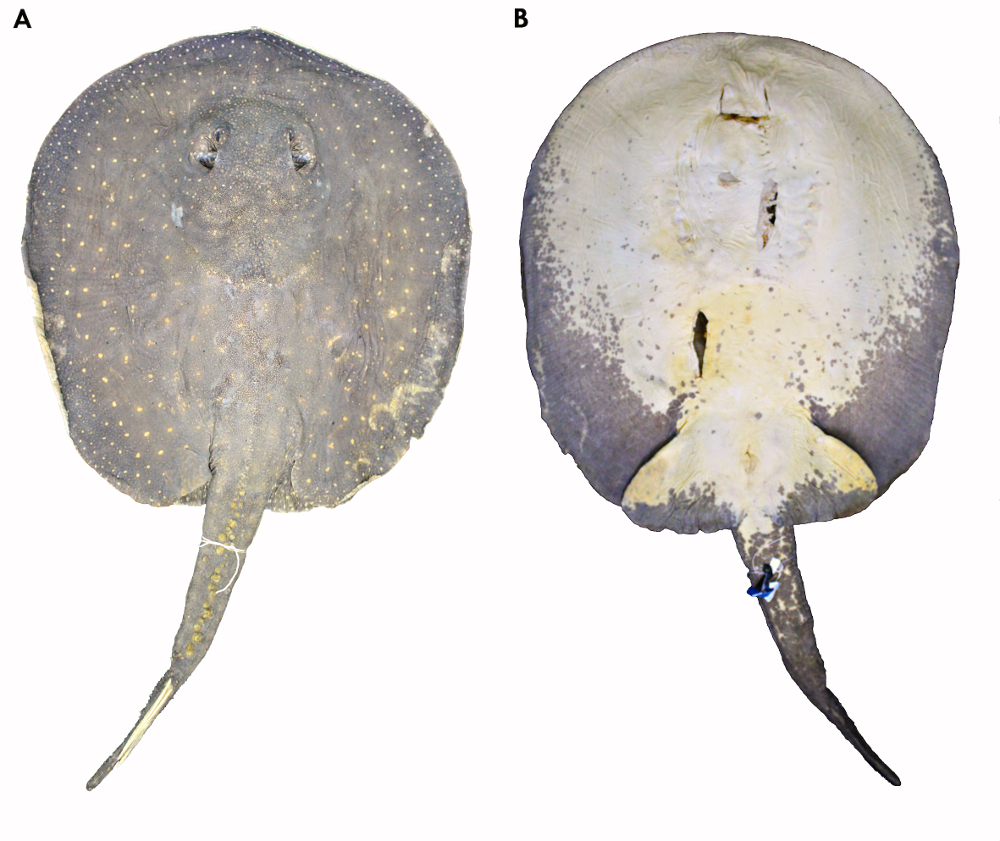Potamotrygon adamastor
Fontenelle & De Carvalho, 2017
Classification: Elasmobranchii Myliobatiformes Potamotrygonidae
Reference of the original description
Systematic revision of the Potamotrygon scobina Garman, 1913 species-complex (Chondrichthyes: Myliobatiformes: Potamotrygonidae), with the description of three new freshwater stingray species from Brazil and comments on their distribution and biogeography. Zootaxa, 4310(1), 1–63
Systematic revision of the Potamotrygon scobina Garman, 1913 species-complex (Chondrichthyes: Myliobatiformes: Potamotrygonidae), with the description of three new freshwater stingray species from Brazil and comments on their distribution and biogeography. Zootaxa, 4310(1), 1–63
Description :
Citation: Potamotrygon adamastor Fontenelle & De Carvalho, 2017: In: Database of modern sharks, rays and chimaeras, www.shark-references.com, World Wide Web electronic publication, Version 12/2025
Please send your images of "Potamotrygon adamastor" to info@shark-references.com

Potamotrygon adamastor Fontenelle & De Carvalho, 2017, Holotype, MZUSP 104662, adult female, 545 mm DW, rio Urariquera, rio Branco basin, municipal district of Boa Vista, upper Amazon Basin, state of Roraima, Brazil © João Pedro Fontenelle

Potamotrygon adamastor Fontenelle & De Carvalho, 2017, Holotype, MZUSP 104662, adult female, 545 mm DW, rio Urariquera, rio Branco basin, municipal district of Boa Vista, upper Amazon Basin, state of Roraima, Brazil © João Pedro Fontenelle
Common names
 Adamastor's freshwater stingray
Adamastor's freshwater stingray
 Adamastor's freshwater stingray
Adamastor's freshwater stingray
Short Description
Original diagnosis after FONTENELLE & DE CARVALHO, 2017 [25646]: Potamotrygon adamastor sp. nov. is distinguished from congeners, except P. limai, P. scobina, P. garmani sp. nov., and P. amazona sp. nov., by a combination of characters: dorsal disc dark gray covered with scarce small yellow to white ocelli with a slender dark contour; small irregular spots sometimes present on disc margin; rostral and caudal dermal denticles with a single pointed crown; a single irregular row of enlarged thorns on dorsal tail midline; tail base wide and robust; three angular cartilages of different sizes between jaw and hyomandibula; cartilaginous rod in tail relatively short (smaller than the distance between cloaca and caudal sting origin). Potamotrygon adamastor sp. nov. is distinguished from P. limai by having ocellated spots, not having a light polygonal pattern over the lower back, by having a wider and shorter tail, and fewer thorn rows over dorsal tail midline. From P. scobina and P. garmani sp. nov., by having a considerably thicker, more muscular disc, dermal denticles with fewer dichotomies and smaller basal plates, fewer spots, and a wider and shorter tail (mean tail width 19% DW vs. 13.4% DW in P. scobina and 14.1% DW in P. garmani sp. nov.; mean tail length 78.1% DW vs. 121.5% DW in P. scobina and 100.6% DW in P. garmani sp. nov.). Finally, P. adamastor sp. nov. is distinguished from P. amazona sp. nov. by having fewer dermal denticles on disc, a less elaborate dorsal color pattern (simple and usually with small ocellated spots with dark halos vs. numerous white spots forming clusters in P. amazona sp. nov.), and a shorter tail (mean tail length 78.1% DW vs. 86.1% DW in P. amazona sp. nov.) and internal cartilaginous rod.
Original diagnosis after FONTENELLE & DE CARVALHO, 2017 [25646]: Potamotrygon adamastor sp. nov. is distinguished from congeners, except P. limai, P. scobina, P. garmani sp. nov., and P. amazona sp. nov., by a combination of characters: dorsal disc dark gray covered with scarce small yellow to white ocelli with a slender dark contour; small irregular spots sometimes present on disc margin; rostral and caudal dermal denticles with a single pointed crown; a single irregular row of enlarged thorns on dorsal tail midline; tail base wide and robust; three angular cartilages of different sizes between jaw and hyomandibula; cartilaginous rod in tail relatively short (smaller than the distance between cloaca and caudal sting origin). Potamotrygon adamastor sp. nov. is distinguished from P. limai by having ocellated spots, not having a light polygonal pattern over the lower back, by having a wider and shorter tail, and fewer thorn rows over dorsal tail midline. From P. scobina and P. garmani sp. nov., by having a considerably thicker, more muscular disc, dermal denticles with fewer dichotomies and smaller basal plates, fewer spots, and a wider and shorter tail (mean tail width 19% DW vs. 13.4% DW in P. scobina and 14.1% DW in P. garmani sp. nov.; mean tail length 78.1% DW vs. 121.5% DW in P. scobina and 100.6% DW in P. garmani sp. nov.). Finally, P. adamastor sp. nov. is distinguished from P. amazona sp. nov. by having fewer dermal denticles on disc, a less elaborate dorsal color pattern (simple and usually with small ocellated spots with dark halos vs. numerous white spots forming clusters in P. amazona sp. nov.), and a shorter tail (mean tail length 78.1% DW vs. 86.1% DW in P. amazona sp. nov.) and internal cartilaginous rod.
Dentition
Teeth small and numerous in each jaw, wider than long, set in quincunx, in a narrowly arched upper tooth plate and a wide and trapezoidal lower tooth plate. Tooth rows varying from 50–56 in upper jaw and 45–60 in lower jaw. Adult males presenting a single central pointed cusp on central teeth of both jaws. Lateral teeth, and teeth of juvenile males and females simple, presenting a single but more rounded cusp. [25646]
Teeth small and numerous in each jaw, wider than long, set in quincunx, in a narrowly arched upper tooth plate and a wide and trapezoidal lower tooth plate. Tooth rows varying from 50–56 in upper jaw and 45–60 in lower jaw. Adult males presenting a single central pointed cusp on central teeth of both jaws. Lateral teeth, and teeth of juvenile males and females simple, presenting a single but more rounded cusp. [25646]
Remarks
shark-references Species-ID=14931; CITES: (see: Protected Species for more details) Convention on International Trade in Endangered Speciesof Wild Fauna and Flora annex: III; Council Regulation 2017/160 annex: C
shark-references Species-ID=14931; CITES: (see: Protected Species for more details) Convention on International Trade in Endangered Speciesof Wild Fauna and Flora annex: III; Council Regulation 2017/160 annex: C

















